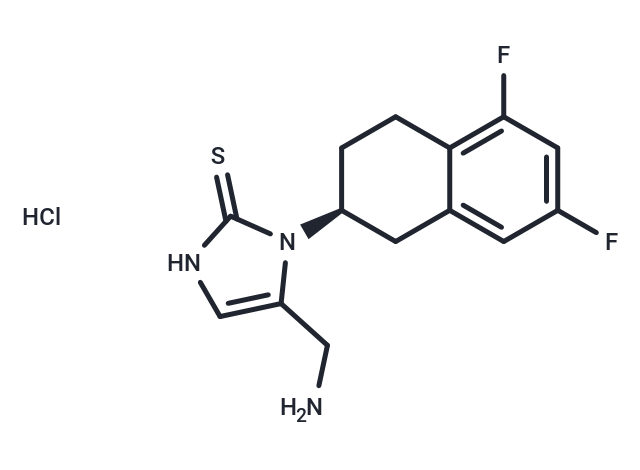Shopping Cart
- Remove All
 Your shopping cart is currently empty
Your shopping cart is currently empty

Nepicastat hydrochloride (RS-25560-197 hydrochloride) is an effective and specific inhibitor, which is used for bovine and human dopamine-β-hydroxylase with IC50 of 8.5 nM and 9 nM, respectively.The affinity of Nepicastat for twelve other enzymes and thirteen neurotransmitter receptors is negligible.

| Pack Size | Price | Availability | Quantity |
|---|---|---|---|
| 5 mg | $52 | In Stock | |
| 10 mg | $89 | In Stock | |
| 25 mg | $159 | In Stock | |
| 50 mg | $271 | In Stock | |
| 100 mg | $476 | In Stock | |
| 500 mg | $1,050 | In Stock | |
| 1 mL x 10 mM (in DMSO) | $57 | In Stock |
| Description | Nepicastat hydrochloride (RS-25560-197 hydrochloride) is an effective and specific inhibitor, which is used for bovine and human dopamine-β-hydroxylase with IC50 of 8.5 nM and 9 nM, respectively.The affinity of Nepicastat for twelve other enzymes and thirteen neurotransmitter receptors is negligible. |
| Targets&IC50 | DBH (human):9 nM, DBH (bovine):8.5 nM |
| In vitro | In vitro, Nepicastat hydrochloride shows the selective and concentration-dependent inhibition effects on bovine and human dopamine-beta-hydroxylase activity with IC50 of 8.5 nM and 9.0 nM, respectively. While Nepicastat hydrochloride has negligible affinity for twelve other enzymes and thirteen neurotransmitter receptors. [1] |
| In vivo | In the artery, left ventricle and cerebral cortex of spontaneously hypertensive rats (SHRs), Nepicastat hydrochloride reduces noradrenaline content, and increases dopamine content and dopamine/noradrenaline ratio in a dose-dependent manner. In addition, Nepicastat hydrochloride also produces the similar effects on noradrenaline, dopamine and dopamine/noradrenaline ratio in tissues and plasma of beagle dogs. [1] In inactin-anesthetized SHRs, Nepicastat hydrochloride (3 mg/kg, i.v.) produces the antihypertensive effects and causes a significant decrease in renal vascular resistance (38%) and an increase in renal blood flow (22%). [2] In dogs with chronic heart failure, low-dose Nepicastat hydrochloride (0.5 mg/kg) prevents left ventricular (LV) dysfunction and remodeling, and combination therapy of Nepicastat hydrochloride and enalapril results in additional improvements in all morphological features. [3] In rat brain, Nepicastat hydrochloride at a dose of 50 mg/kg ( i.p.) leads to the reduction of norepinephrine (NE) and blocks cocaine-primed reinstatement of cocaine seeking. [4] |
| Alias | SYN-117 hydrochloride, RS-25560-197 hydrochloride, Nepicastat HCl, Nepicastat (SYN-117) HCl |
| Molecular Weight | 331.81 |
| Formula | C14H15F2N3S·HCl |
| Cas No. | 170151-24-3 |
| Smiles | Cl.NCc1c[nH]c(=S)n1[C@H]1CCc2c(F)cc(F)cc2C1 |
| Relative Density. | no data available |
| Storage | Powder: -20°C for 3 years | In solvent: -80°C for 1 year | Shipping with blue ice. | |||||||||||||||||||||||||||||||||||
| Solubility Information | DMSO: 50 mg/mL (150.69 mM), Sonication is recommended. | |||||||||||||||||||||||||||||||||||
Solution Preparation Table | ||||||||||||||||||||||||||||||||||||
DMSO
| ||||||||||||||||||||||||||||||||||||

Copyright © 2015-2025 TargetMol Chemicals Inc. All Rights Reserved.